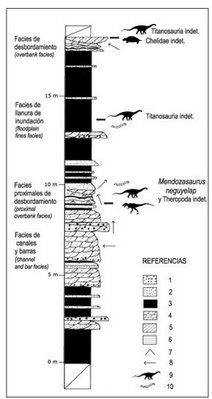
Abstract: In South America, most titanosaur species are represented by incomplete skeletal elements lacking well-preserved cervical vertebrae. In this context, the discovery of cervical remains assigned to Mendozasaurus neguyelap González Riga is relevant from a systematic viewpoint. The fossils were found in the paleontological site and assemblage of the holotype, Río Neuquén Subgroup, late Turonian – late Coniacian from Mendoza Province, Argentina.
The cervical vertebrae of Mendozasaurus exhibit differences with those of most titanosaurs; however, they share with Isisaurus colberti (Jain and Bandyopadhyay) from Maastrichthian of India the presence of: a) short vertebral centra (ratio: total length/height of cotyle less than 2.5), b) large and deep supradiapophyseal fossa, and c) relatively tall neural spines (ratio: vertebral height/centrum length more than 1.5).
The fossils recovered show an autapomorphic character that enlarges the diagnosis of Mendozasaurus: tall, laminar and transversally expanded mid-posterior cervical neural spines that are wider than vertebral centra and ‘fan-like' or ‘subrhomboid' in shape due to lateral expansions and a subrounded dorsal border. The fossil record of titanosaurs shows a notable morphologic diversity in the cervical series. In particular, Mendozasaurus neguyelap and Isisaurus colberti possess tall neural spines associated with the proportionally shortest cervical centra of any titanosaur. This unusual morphology suggests the development of relatively wide, robust and short necks in Late Cretaceous sauropods from Argentina and India.
Thanks to Dr. Eric Snively for pointing out this older but still interesting paper to the Palaeoblog!
